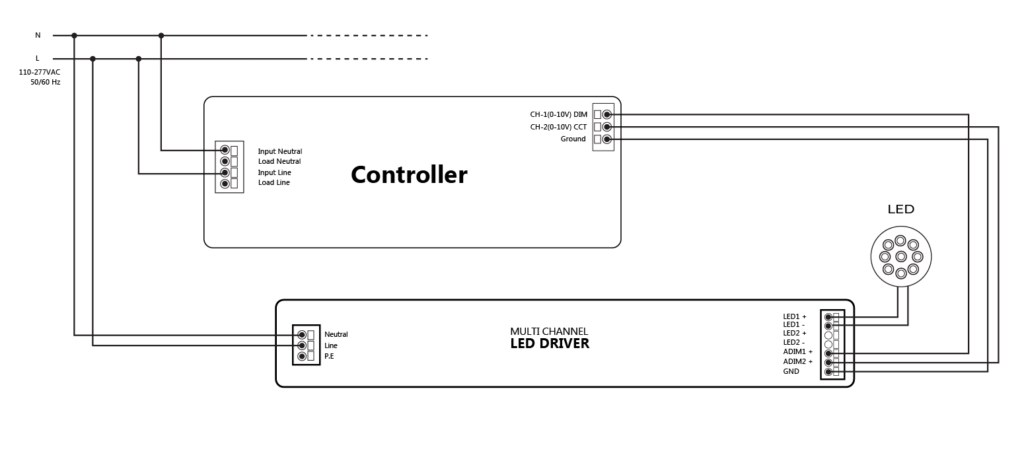Here’s What Really Matters in 0-10V Dimming

When reclining on your bed, you can control your lighting. You can turn it ON/OFF or DIM to the light level of your choice. That is way too smart. So how does it happen? Obviously because of lighting control technology! Have you ever thought, how does lighting control technology make this happen?
Well! We will share our insights.
We are starting with the most widely used lighting control technology, 0-10V. Since it is a vast topic to discuss, we have decided to package this as a series of blogs to be more convenient for you.
This blog will focus on the basics of 0-10V and some interesting facts that you would love to learn!
So what is 0-10V Dimming?
0-10V dimming is the widely used lighting control protocol and the first electronic lighting control signaling system. To DIM the light, it varies the DC voltage between 0-10V. It is most suitable when you are looking for energy savings and quality lighting that suits different tasks.
If you want to know more about 0-10V dimming, you can read here- Lighting Control Protocols: DALI, 0-10V, DMX, PWM – What is your choice?
| 1-10V Vs 0-10V dimming The main difference between 1-10V and 0-10V dimming is the current direction. 1-10V can DIM the load down to 10%, while the 0-10V can DIM the load down to 0% (DIM to OFF). A 0-10V dimmer is a 4-wire device that receives an AC power signal and converts it to a DC 0-10V dimming signal based on the user input. |
How does 0-10V Dimming Work?

In the 0-10V dimming, when the controller receives the message to provide the required light intensity via the user interface (APP/Switches/Remote), it sends the voltage value to the driver via 0-10V wire. The driver will then respond to the corresponding value and adjust the intensity of the light devices. For example: If the controller receives 0 V as an input value, the driver will respond accordingly to this input value, and the luminaires will be turned OFF. However, in 1-10V dimming, the driver should be powered via relay (switch) to turn OFF the lights completely.
| 0-10V mA Rating Every 0-10V device has a rating that determines the amount of current it sources or sinks. The IEC 60929 (International Standard created by the International Electro Technical Commission) standard dictates a minimum ballast source current of 10 µA and a maximum of 2 mA. Understanding the sink and source current is crucial to decide the maximum number of ballasts/drivers that a single control circuit can manage. Now let us get into the details of Current Source and Current Sink. Current Source Vs Current Sink In current source, the controller or dimmer is the source, and the driver is the sink. Here the current flows from the dimmer and is measured at the driver as per 0-10V specification.  In Current Sink, the driver is the source, and the controller or dimmer is the sink. Here the current flows from the driver to the dimmer, which modifies the current returning to the circuit.  Did you know? For the control and the driver to work together, the device might need one source and the other that can sink. Some devices can take either role through the auto sink or source detection. Relay Rating It defines the total amount of current that runs through the controls to power the connected fixtures. The relay rating defines the maximum allowable current a lighting circuit can have, and the number of drivers that can be used. Inrush Current Inrush current is also known as the switch–ON surge or the input surge current. It is the instant high input current drawn by the device when its turned ON. We should ensure surge protection for devices to avoid damages. |
Where to Use a 0-10V Dimming?
0-10v dimming was developed as a standard method to control the light intensity. As LED technology progressed, 0-10V gained popularity as the most reliable dimming method. It can be used in :
- Retail spaces
- Offices and homes
- Outdoor spaces
- Spaces where multipurpose lighting is required
The Advantages of Dimming from 0 to 10 Volts
- Right light
- Longer lifespan for LED lamps
- Ideal for retrofit applications
- Efficiency
You can read more about 0-10V controller portfolio here.
To discuss more about 0-10V controls contact our lighting experts. Our next blog will be on 0-10V wiring, and you can learn about types of wiring, wiring methods, latest wiring updates and more.
Please comment your thoughts and feel free to reach us!